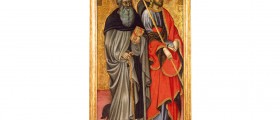> Home > >

I Santi Antonio abate e Giacomo maggiore Siena
Artist: Priamo della Quercia
Current location: Museo di San Donato - Collezione di Banca MPS
Original location:
DESCRIPTIVE INFORMATION
dimensions
108 x 62 cm
The painting was originally the left side compartment of a polyptych. Priamo della Quercia, brother of the famous sculptor Jacopo, moves within the purely late Gothic cultural climate which in Tuscany finds its greatest expressions in the paintings of Gherardo Starnina, Lorenzo Monaco and Alvaro Pirez: in fact, the figurative culture of these artists refers to the a taste for the elegant and complicated handwriting of the draperies which, similar to exotic plant presences, envelop the bodies of the two figures, frustrating their physical consistency; characteristic of our painter is instead the use of a dense and smoky chiaroscuro that imbues the clothes and physiognomies of the characters, weighing them down. The figure of Saint Anthony the Abbot - together with that of the apostle James - enjoyed a huge veneration in the Middle Ages. Brother of San Giovanni Evangelista, together with San Giovanni and San Pietro Giacomo was chosen by Jesus as a witness of the Master's greatest miracles. In our painting, San Giacomo holds in his hand a long stick from which hangs, half-hidden by the saint's shoulder, a hat with wide brim: peculiar attributes of the pilgrim, hat and stick in fact accompanied the clothing of all the faithful who from all over the world Christians went on pilgrimage to the Sanctuary of Compostella, in Galicia, where tradition wanted the mortal remains of the Holy Apostle to be kept. In Sant'Antonio abbot the Christian faith recognizes one of the founding fathers of monasticism: lived between the third and fourth centuries after Christ in the solitude of the Egyptian desert, the elderly saint wore the dark habit and the gray cloak typical of the ancient hermits, costumes which also refer to the stick in the shape of a "tau" and the small bell hung on it which, jingling under the gait of the steps, signaled the presence of the holy men to anyone who was in the immediate vicinity. The small wild boar that appears, curious, behind the figure of the Saint is a clear allusion to the popular belief - still very much alive today - which recognizes the patron of the animal genus in Saint Anthony the Abbot.
I Santi Antonio abate e Giacomo maggiore




